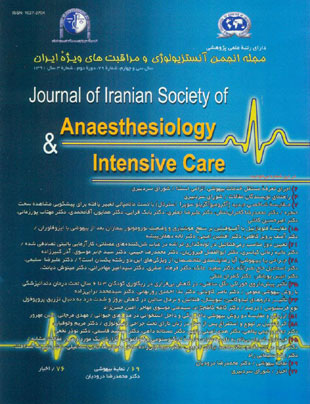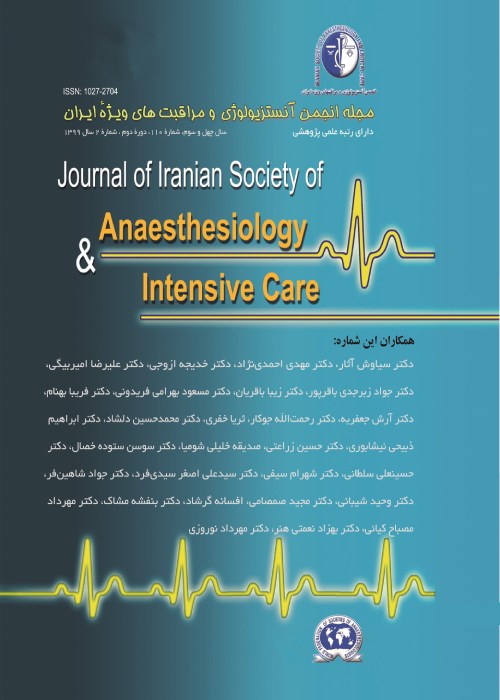فهرست مطالب

فصلنامه آنستزیولوژی و مراقبتهای ویژه ایران
سال سی و چهارم شماره 3 (پیاپی 79، پاییز 1391)
- تاریخ انتشار: 1391/10/09
- تعداد عناوین: 12
-
-
صفحه 69
-
صفحه 76
-
Page 7IntroductionWe aimed to compare the efficacy of a new bedside screening test named Acromio Axillo Suprasternal notch index (AASI) with modified Mallampati test(MMT).Materials And Methods603 adult patients, who were candidates for tracheal intubation under elective surgery, were enrolled in this prospective study. Preoperative airway assessments were carried out with AASI and MMT. The new AASI test is calculated as follow: 1) Using a ruler a line is drawn vertically from the top of the acromion process to the superior border of the axilla at the pectoralis major muscle named as line A.2) A second line is drawn perpendicular to line A from the suprasternal notch (line B); and 3)That portion of line A that lies above where line B bisects line A is line C. AASI is calculated from the length of line C divided by line A(AASI= C/A) After induction of anaesthesia, laryngeal view according to the Cormack- Lehane grading system was recorded.Receiver operating characteristic (ROC) curve analysis was employed to compare AASI with MMT.ResultsDifficult visualization of larynx (DVL,Cormack - Lehane III & IV) was observed in 38 (6.3%) of patients. The best cut off point for DVL was defined at AASI≤0.49. AASI had a lower false negative and higher predictive values) compared with MMT.ConclusionAASI was associated with higher predictive values than MMT and could be recruited for estimation of DVL.Keywords: Anesthesia, Difficult, Laryngoscopy, Intubation
-
Page 15IntroductionRecovery from anesthesia induced with inhalation agents can be distressing because of prolonged mental function deficiency, disorientation and abnormal neurological reflexes. So we designed this study to compare the effect of flumazenil versus aminophylline on cognitive and neuromotor status after isoflurane anesthesia.Materials And MethodsTo conduct this randomized, placebo-controlled, double-blinded study, 90 ASAI-II patients who underwent orthopedic surgery under N2O/O2 plus isoflurane anesthesia were administered flumazenil 1mg,aminophylline 2mg/Kg or placebo upon emergence from anesthesia, and their vigilance and neurological recovery were assessed.ResultsComparison of three groups in vigilance score showed significant statistical difference at minute 5, 10, 20. (p<0.001, p=0.016). Recovery of vigilance in flumazenil treated patients compared to those who received aminophylline was faster at minutes of 5, 10 and 20 (p=0.001, p=0.001, p=0.038) and in aminophylline treated patientscompared to placebo group was better at 5, 10, 20 and 30 minutes (p<0.001, p=0.1001, p=0.008 and p=0.04).Neurological score between there groups at 5,10, 20, 30 minutes has signification statistical difference(p<0.001, p<0.001, p=0.001 and p=0.048).Neurological score showed better recovery of flumazenil treated patients compared toaminophylline treated patients at minutes 5 and 10 (p=0.001, p=0.005). Neurologic recovery in aminophyllne group was faster than placebo group at minute 5, 10 and 20 (p=0.028, p=0.001, and p=0.013).ConclusionThis study showed that bolk flumazenil and amynophyline are effective in improving recovery of vigilance and neuromotor functions following isoflurane anesthesia, but flumazenil proved to be more effective.Keywords: Flumazenil, aminophylline, isoflurane anesthesia, vigilance, neuromotor functions
-
Page 21IntroductionMuscle relaxants facilitate tracheal intubation, but in situations where their use is unnecessary or contraindicated, avoiding them seems logical. The aim of this study was to compare the effects of two doses of remifentanil combined with propofol and lidocaine for tracheal intubation without muscle relaxants.Materials and MethodsIn a randomized clinical study 162 patients with ASA class I and II scheduled for elective surgery, were equally divided in to two groups receiving remifentanil 2 or 3μg/kg. All the patients received lidocaine 1.5 mg/kg and propofol 2 mg/kg.Laryngoscopy and tracheal intubation were performed 90 seconds after anesthesia induction. The status of laryngoscopy and tracheal intubation was assessed using status and movement of vocal cords, airway reaction and limbs movement. Blood pressure (BP) and heart rate (HR) were measured before anesthesia induction (as baseline), immediately and 3min after laryngoscopy.Results were compared between two groups using SPSS 15.ResultsThere was a significant difference between two groups for vocal cord status (p=0.001) and movement (p=0.002) and limbs movement (p=0.013), but therewas no significant difference between two groups for airway reaction. However decline in BP and HR was confirmed in all the patients, but assessment of BP and HR in two groups showed that only decrease in systolic blood pressure was significant before drug administration compared to 3 min subsequent larynxgoscopy (p=0.002). HR showed significant difference between two groups only before drug administration with immediately after laryngoscopy (p=0.002).ConclusionThis study confirmed that combination of propofol, lidocaine and remifentanil (2 and 3 μg/kg) without muscle relaxants prepare appropriate situationfor laryngoscopy and tracheal intubation. However the higher dose of remifentanil was preferred, but associated with severe decline in BP and HR.Keywords: Remifentanil, Propofol, Lidocaine, Laryngoscopy, Tracheal intubation
-
Page 28IntroductionChoosing a specialty by young medical students is difficult and stressful. Aknowledge of the characteristics of a specialty from its specialists is very helpful. In this systematic study, we compare the characteristics of the two specialties – anesthesiology and surgery regarding stress, satisfaction, hope for future and personal liking.Materials And Methods120 specialist were selected in a cross–sectional randomized study in two congress. They were divided into two groups, each group comprising of 60 Specialists. They were asked to fill a concealed self - assessmentquestionnaire. The variable included demographic data, stress level, satisfaction, future hope and current and future aspects of their specialty.ResultsTwo groups (anesthesiologists and surgeans) were matched for demograpic, age and sex. There were no significant differeces between various characteristics of two groups except for higher stress level among anesthesiologists (p <0.05).There was no correlation between duration time of occupation and level of satisfaction in the two groups (r = 0.325). Duration time of occupation was inversely correlated to stress level (r = -0.78). Current jab satisfaction was significantly different between anesthesiology and surgery (p<0.05), however future jab satisfaction was not.DiscussionJob satisfaction is almost equall in anesthesiologists and surgeans. Duration time of occupation do not increase job satisfaction in any of two specialties. Anesthesiologists harbor more stress and less current satisfaction compare to surgeons,but their future hope is the same for the future.Keywords: Surgery, Anesthesiology, Satisfaction
-
Page 35IntroductionDental anxiety is caused by failure to provide quality services to patients. The oral medication is one way of controlling anxiety.Passion Flower is known as a sedative drug in traditional herbal medicine. This study aimed to determine the effect of passionflower extracts to reduce restlessness in children 3 to 6 years undergoing general anesthesia.Methods and materials: 50 healthy children aged 3 to 6 candidate for dental treatment under general anesthesia, after examination and consent from the parents were selected. Extract of Passion flower given to study group(25 children) and a similarvolume of oral sugar solution to control group.Separation from parents, cooperation for IV line and agitation score in recovery room was evaluated in two groups.ResultsEasy separation from their parents in the study group was 56% and 33% also had good cooperation for IV line, which was significantly more than control group. The agitation score of the study group in the minutes 10 and 20 and 30 of recovery room were significantly lower than controls.DiscussionExtract of Passion flower makes easier separation from parent and higher cooperation for IV line and lower agitation score and need to analgesia in recovery room. So this drug was useful for premedication in children.Keywords: Passion flower (passiflora incarnata L), Agitation, General anesthesia, Anxiety separation
-
Page 44IntroductionPropofol is widely used because it provides pleasant anesthesia and rapid recovery.However pain on injection is one main side effect of propofol continues to be an undesirable problem.This study deal with comparing the effect of thiopental, lidocaine, fentanyl, normal salinecompare with placebo admixture with propofol on injection pain induced by propofol.Materials And MethodsThis double blind clinical trial study was conducted on 257 patients which were randomly allocated to one of five groups to receive only 2mg/kg of propofol type fresenius 1% in group I, 2 cc of lidocaine 1% in group II, 2 ml of normal saline 0.09% in group III, 50 mg sodium thiopental in group IV and group V were injected100 μg fentanyl before injection of Propofol. Verbal Rating Scale was evaluated for documenting pain.ResultsA significant decrease in the severity of pain during injection was achieved in group II (thiopental) and IV (lidocaine) campared to the three other group. Fentanyl was also effective to reduce moderate pain.ConclusionWe found thiopental and lidocaine were more effective in reducing the incidence and severity of pain injection than the other three groups. Thus it seems to be more appropriate as an alternative method to diminish propofol injection pain than the other treatments used in this study.Keywords: Injection pain, Propofol, Attenuation
-
Page 51IntroductionVarious methods are used for inducing anesthesia. This study comparedintravenous and intraosseous propofol anesthesia in the animal model.Materials And Methods12 healthy adult cats (5male and 7 female) in two groups, intravenous (IV) and intraosseous (IO) were studied. In both IV and IO groups 8 mg propofol per kg body weight was injected. Heart rate, respiratory rate, pulse rate,rectal temperature, ETCo2, SPO2, quality of anesthesia and recovery were evaluated and recorded before and after injection of propofol in 0,5, 10, 15, 20, 25 and 30 minutes. Independent t test was used and a p value < 0.05 was considered to be significant.ResultsThe average recovery time in the (IV)method was 52/5±9/72 minutes and in the (IO)method 26/14±90 minutes and there was no ignificant difference for recovery time (p= 0/549).Information about depth of anesthesia (p= 0/1171) and quality of recovery (p=0/3404) were found to have no significant difference p >(0/05).DiscussionSatisfactory results were recorded in anesthesia with propofol in both intravenous and intraosseous groups. Intraosseous anesthesia is desirable and faster in emergency situations in and cases with difficult vascular access.Keywords: Intraosseous anesthesia, Intravenous anesthesia, Anesthetic drug administration, Animal model
-
Page 58IntroductionPostoperative nausea and vomiting (PONV) is the second most common complaint of patients after surgery which may be the limiting factor in patient discharge from hospital especially after ambulatory surgery.This study aimed to compare the efficacy of ginger in reducing post operative nausea and vomiting in unfertilized women after gynecologic laparoscopic surgery.Materials And MethodsThe present study is a double blind, randomized placebo controlled trial. A total number of 60 patients, aged between 20 to 50 years who were scheduled for gynecologic laparoscopic surgery participated in the trial. The patients were divided into two groups by random allocation. The first group received placebo capsules and the second one received ginger capsules (500 milligrams) one hour before anesthesia induction. The severity of nausea was measured with NRS (Numerical Rating Scale) - a measurement technique – and vomiting episodes was assessed based on occurance of it at 0,2,6 and 24 hours after surgery.ResultsThere was significant difference between two groups in respect of post operative nausea only at 0 hour after surgery (pvalue: 0.016),while there was no significant difference in vomiting episodes (p value: 1.0).ConclusionThis study indicated if ginger capsule (dose of 500 milligrams) is prescribed for patients one hour before anesthesia induction, it has beneficial effect in reducing post operative nausea immediately after surgery, in comparison with placebo.Keywords: Postoperative nausea, vomiting, Ginger, Gynecologic laparoscopy
-
Page 65
Anesthesiologists perform minimally invasive bedside precutanous dilated tracheostomy and it is expected that it should have fewer complication for being less invasive. Tracheo-inniminate artery fistula (TIF) is a rare, life threatening and catastrophic complication, which may occur 7 to 14 days after surgery. The incidence rare of TIF is 0.1-1% and survival rate of patient is 14.3%. Herein, we describe TIF in a PDT patient improved because of timely diagnosis and surgical treatment.
Keywords: Percutaneous Dilated Tracheostomy, Complication, Case Report, Tracheo, Innominate Artery Fistula


